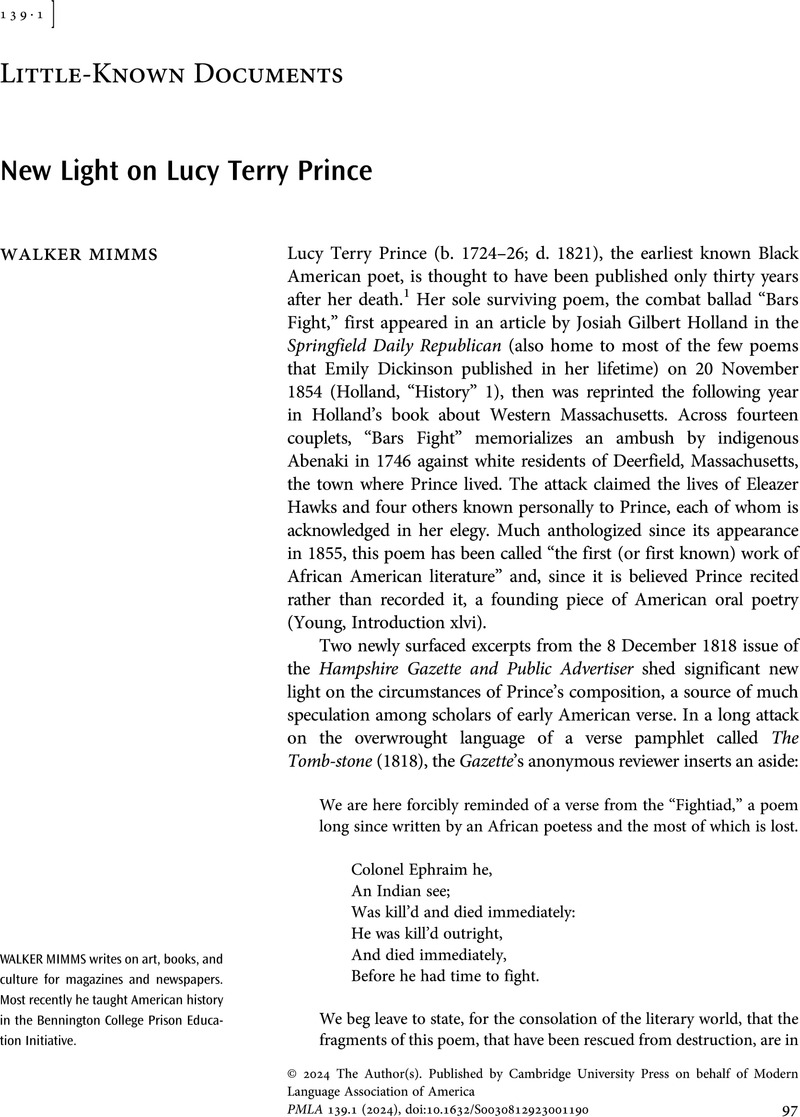No CrossRef data available.
Article contents
New Light on Lucy Terry Prince
Published online by Cambridge University Press: 17 April 2024
Abstract
An abstract is not available for this content so a preview has been provided. Please use the Get access link above for information on how to access this content.

- Type
- Little-Known Documents
- Information
- Copyright
- Copyright © 2024 The Author(s). Published by Cambridge University Press on behalf of Modern Language Association of America
References
Works Cited
Arms, Pliny. “History of Deerfield.” Circa 1840s. Arms Family Papers, Pocumtuck Valley Memorial Association, Deerfield, Massachusetts, box 13, folder 17.Google Scholar
Burns, Robert. Poems, Chiefly in the Scottish Dialect, by Robert Burns, to Which Are Added, Scots Poems, Selected from the Works of Robert Ferguson. J. and A. M'Lean, 1788.Google Scholar
Gerzina, Gretchen Holbrook. Mr. and Mrs. Prince: How an Extraordinary Eighteenth-Century Family Moved out of Slavery and into Legend. Amistad, 2008.Google Scholar
Hammon, Jupiter. An Evening Thought: Salvation by Christ, with Penitential Cries. New York, 1761.Google Scholar
Harris, Sharon. Executing Race: Early American Women's Narratives of Race, Society, and the Law. Ohio State UP, 2005.Google Scholar
Holland, Josiah Gilbert. History of Western Massachusetts: The Counties of Hampden, Hampshire, Franklin, and Berkshire. Samuel Bowles, 1855. 3 vols.Google Scholar
Holland, Josiah Gilbert. “History of Western Massachusetts: The Counties of Hampden, Hampshire, Franklin and Berkshire: Part III: Individual Histories of the One Hundred Towns in the Four Western Counties.” Springfield Daily Republican, vol. 11, no. 274, 20 Nov. 1854, pp. 1–2.Google Scholar
Holland, Josiah Gilbert. Manuscript letter to Henry Vose, 21 Apr. 1857. Richard Ford, www.richardfordmanuscripts.co.uk/catalogue/11385. Accessed 24 Oct. 2022.Google Scholar
Hutchins, Zachary McLeod, and Smith, Cassander L., editors. The Earliest African American Literatures: A Critical Reader. U of North Carolina P, 2021.CrossRefGoogle Scholar
Johnson, Samuel, editor. The Lives of the Most Eminent English Poets, with Critical Observations on Their Works. Bathurst et al., 1781. 4 vols.Google Scholar
Kaplan, Sidney, and Kaplan, Emma Nogrady. The Black Presence in the Era of American Revolution. Rev. ed., U of Massachusetts P, 1989.Google Scholar
Katz, Bernard. “A Second Version of Lucy Terry's Early Ballad?” Negro History Bulletin, vol. 29, no. 8, fall 1966, pp. 183–84.Google Scholar
Percy, Thomas, editor. Reliques of Ancient English Poetry: Consisting of Old Heroic Ballads, Songs, and Other Pieces of Our Earlier Poets. Dodsley, J., 1765. 3 vols.Google Scholar
Review of The Tomb-stone, to the Memorial of Ezekiel Reed, Formerly of the Town of Woburn, Mass. Hampshire Gazette and Public Advertiser, 8 Dec. 1818, p. 2.Google Scholar
Sheldon, George. “Negro Slavery in Old Deerfield.” New England Magazine, vol. 8, Mar. 1893, pp. 49–60.Google Scholar
The Tomb-stone, to the Memorial of Ezekiel Reed, Formerly of the Town of Woburn, Mass. Massachusetts, 1818.Google Scholar
Young, Kevin, editor. African American Poetry: Two Hundred Fifty Years of Struggle and Song. Library of America, 2020.Google Scholar


